Semi-steel is not actually a true form of steel by industry classification, but instead is a high-grade form of iron. It is made by combining scrap iron along with scrap steel, usually in a cupola furnace where cast iron and bronze metals are refined. Since semi-steel has a significant steel component to it, it is softer than regular iron. It is generally not heat-treated to maintain this level of softness, so that it can be used for ornamental iron work uses as well as in producing heavy-duty machine frames. The production of semi-steel has taken place since at least the mid 1800s, when pig iron casting was more commonly done to produce wrought iron fences and other commercial products.
The casting of semi-steel can result in various grades of the product depending on the quality of steel and iron used, as well as the level of heat treating in the furnace to purify the end product. The grade of semi-steel is increased if rail croppings are used, which are the ends of a cast ingot bloom or rail produced during steel refining. If scrap is the main component used in producing semi-steel and it has a high level of impurities to it, then it is considered to be a poorer grade of product than that produced in gray iron casting. Gray iron is a type of cast iron that displays a gray color when it fractures, and is the most common type of iron used to make products from cookware to engine blocks in automobiles.

Since semi-steel is a general term that has varying definitions based on the components of the material, it is often referred to in construction blueprints where it can mean a variety of different things. The material is commonly used as a lower-grade reinforcing material in radial tires than ordinary steel, often produced in Chinese manufacturing. Another frequent use for semi-steel is in the manufacture of safe deposit boxes in bank vaults. Portable and larger safes also use semi-steel for the frame, where a heavy, heat-resistant metal is ideal without it having to be as malleable or fracture-resistant as higher-grade steel.
Metalworking applications where expensive high-grade steels are not required, but materials that are less likely to fracture than iron often call for semi-steel grades. Casters, which are a wheel and bracket unit mounted on the bottom of many industrial and commercial carts and machine racks, are also often made from semi-steel. Their heavy-duty, durable properties make casters able to stand up to weights of 800 to 1,200 pounds each (363 to 544 kilograms) over long periods of time.
